Volatile Profile Characterization of Commercial Peach (Prunus persica) Cultivars Grown in Georgia, USA
Abstract
:1. Introduction
2. Materials and Methods
2.1. Plant Materials
2.2. Sample Preparation
2.3. Isolation of Volatiles
2.4. GC–MS Analysis
2.5. Identification of Volatile Compounds
2.6. Data Analysis
3. Results and Discussion
3.1. Identification of Volatile Compounds
3.2. Volatile Compounds’ Composition
3.3. Aldehydes
3.4. Alcohols
3.5. Esters
3.6. Lactones
3.7. Terpenoids
3.8. Principal Component Analysis
3.9. Cluster Analysis
4. Conclusions
Supplementary Materials
Author Contributions
Funding
Institutional Review Board Statement
Informed Consent Statement
Data Availability Statement
Acknowledgments
Conflicts of Interest
References
- Causse, M.; Stevens, R.; Amor, B.B.; Faurobert, M.; Muños, S. Breeding for Fruit Quality in Tomato. In Breeding Fruit Quality; Jenks, M.A., Bebeli, P.J., Eds.; Wiley: New York, NY, USA, 2011; pp. 279–305. [Google Scholar] [CrossRef]
- Bruhn, C.M. Consumer and Retailer Satistfaction with the Quality and Size of California Peaches and Nectarines. J. Food Qual. 1994, 18, 241–256. [Google Scholar] [CrossRef]
- Derail, C.; Hofmann, T.; Schieberle, P. Differences in key odorants of handmade juice of yellow-flesh peaches (Prunus persica L.) Induced by the workup procedure. J. Agric. Food Chem. 1999, 47, 4742–4745. [Google Scholar] [CrossRef] [PubMed]
- Chapman, G.W.; Horvat, R.J.; Forbus, W.R. Physical and Chemical Changes During the Maturation of Peaches (cv. Majestic). J. Agric. Food Chem. 1991, 39, 867–870. [Google Scholar] [CrossRef]
- Aubert, C.; Günata, Z.; Ambid, C.; Baumes, R. Changes in physicochemical characteristics and volatile constituents of yellow- and white-fleshed nectarines during maturation and artificial ripening. J. Agric. Food Chem. 2003, 51, 3083–3091. [Google Scholar] [CrossRef] [PubMed]
- Wang, Y.; Yang, C.; Li, S.; Yang, L.; Wang, Y.; Zhao, J.; Jiang, Q. Volatile characteristics of 50 peaches and nectarines evaluated by HP-SPME with GC-MS. Food Chem. 2009, 116, 356–364. [Google Scholar] [CrossRef]
- Horvat, R.J.; Chapman, G.W. Comparison of Volatile Compounds from Peach Fruit and Leaves (cv. Monroe) during Maturation. J. Agric. Food Chem. 1990, 38, 1442–1444. [Google Scholar] [CrossRef]
- Eduardo, I.; Chietera, G.; Bassi, D.; Rossini, L.; Vecchietti, A. Identification of key odor volatile compounds in the essential oil of nine peach accessions. J. Sci. Food Agric. 2010, 90, 1146–1154. [Google Scholar] [CrossRef] [PubMed]
- Spencer, M.D.; Pangborn, R.M.; Jennings, W.G. Gas Chromatographic and Sensory Analysis of Volatiles from Cling Peaches. J. Agric. Food Chem. 1978, 26, 725–732. [Google Scholar] [CrossRef]
- Do, J.Y.; Salunkhe, D.K.; Olson, L.E. Isolation, Identification and Comparison of the Volatiles of Peach Fruit as Related to Harvest Maturity and Artificial Ripening. J. Food Sci. 1969, 34, 618–621. [Google Scholar] [CrossRef]
- Bacvonkralj, M.; Jug, T.; Komel, E.; Fajt, N.; Jarni, K.; Živković, J.; Mujić, I.; Trutić, N. Effects of ripening degree and sample preparation on peach aroma profile characterization by headspace solid-phase microextraction. Turkish J. Agric. For. 2014, 38, 676–687. [Google Scholar] [CrossRef] [Green Version]
- Jia, H.J.; Araki, A.; Okamoto, G. Influence of fruit bagging on aroma volatiles and skin coloration of “Hakuho” peach (Prunus persica Batsch). Postharvest Biol. Technol. 2005, 35, 61–68. [Google Scholar] [CrossRef]
- Robertson, J.A.; Horvat, R.J.; Lyon, B.G.; Meredith, F.I.; Senter, S.D.; Okie, W.R. Comparison of Quality Characteristics of Selected Yellow-and White-fleshed Peach Cultivars. J. Food Sci. 1990, 55, 1308–1311. [Google Scholar] [CrossRef]
- Blaauw, B.; Brannen, P.; Lockwood, D.; Schhnabel, G.; Ritchie, D. Southeastern Peach, Nectarine and Plum Pest Management and Culture Guide; Bulletin 1171; University of Georgia Cooperative Extension: Athens, GA, USA, 2018; pp. 1–78. [Google Scholar]
- Belisle, C.; Phan, U.T.X.; Adhikari, K.; Chavez, D.J. A fruit quality survey of peach cultivars grown in the Southeastern United States. Horttechnology 2018, 28, 189–201. [Google Scholar] [CrossRef]
- Montero-Prado, P.; Bentayeb, K.; Nerín, C. Pattern recognition of peach cultivars (Prunus persica L.) from their volatile components. Food Chem. 2013, 138, 724–731. [Google Scholar] [CrossRef] [PubMed]
- Kakiuchi, N.; Ohmiya, A. Changes in the Composition and Content of Volatile Constituents in Peach Fruits in Relation to Maturity at Harvest and Artificial Ripening. J. Jpn. Soc. Hort. Sci. 1991, 60, 209–216. [Google Scholar] [CrossRef] [Green Version]
- Takeoka, G.R.; Jennings, W.; Flath, R.A.; Güntert, M. Nectarine volatiles: Vacuum steam distillation versus headspace sampling. J. Agric. Food Chem. 1988, 36, 553–560. [Google Scholar] [CrossRef]
- El Hadi, M.A.M.; Zhang, F.J.; Wu, F.F.; Zhou, C.H.; Tao, J. Advances in fruit aroma volatile research. Molecules 2013, 18, 8200–8229. [Google Scholar] [CrossRef]
- Bononi, M.; Bassi, D.; Tateo, F. “Flavor Intensity” evaluation of two peach fruit accessions and their four offspring at unripe and ripe stages by HS-SPME-GC/MS. Food Public Health 2012, 2, 301–308. [Google Scholar] [CrossRef]
- Engel, K.H.; Flath, R.A.; Buttery, R.G.; Mon, T.R.; Teranishi, R.; Ramming, D.W. Investigation of volatile constituents in nectarines. 1. Analytical and sensory characterization of aroma components in some nectarine cultivars. J. Agric. Food Chem. 1988, 36, 549–553. [Google Scholar] [CrossRef]
- Zhu, J.C.; Chen, F.; Wang, L.Y.; Niu, Y.W.; Yu, D.; Shu, C.; Chen, H.X.; Wang, H.L.; Xiao, Z.B. Comparison of Aroma-Active Volatiles in Oolong Tea Infusions Using GC-Olfactometry, GC-FPD, and GC-MS. J. Agric. Food Chem. 2015, 63, 7499–7510. [Google Scholar] [CrossRef] [PubMed]

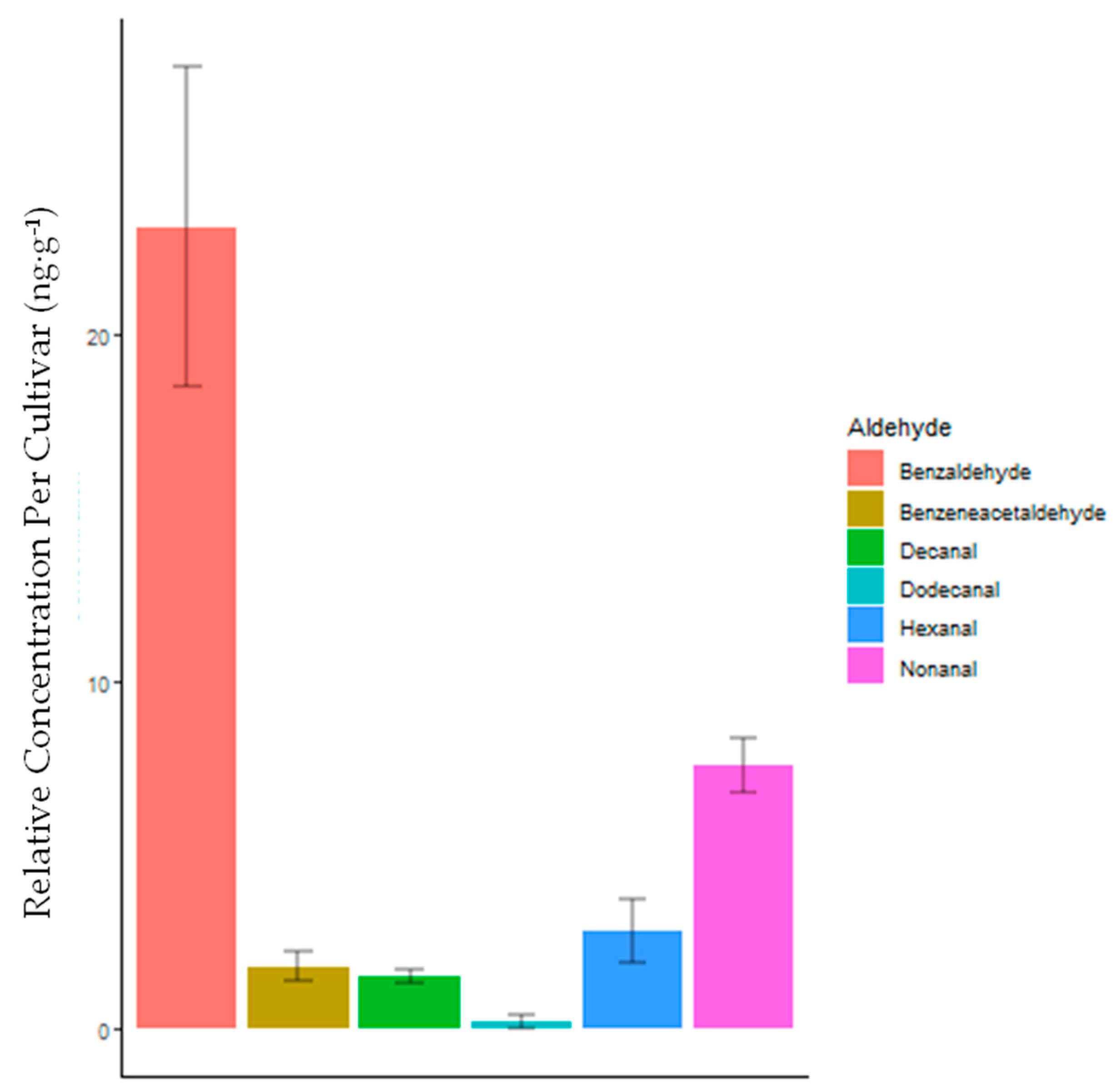

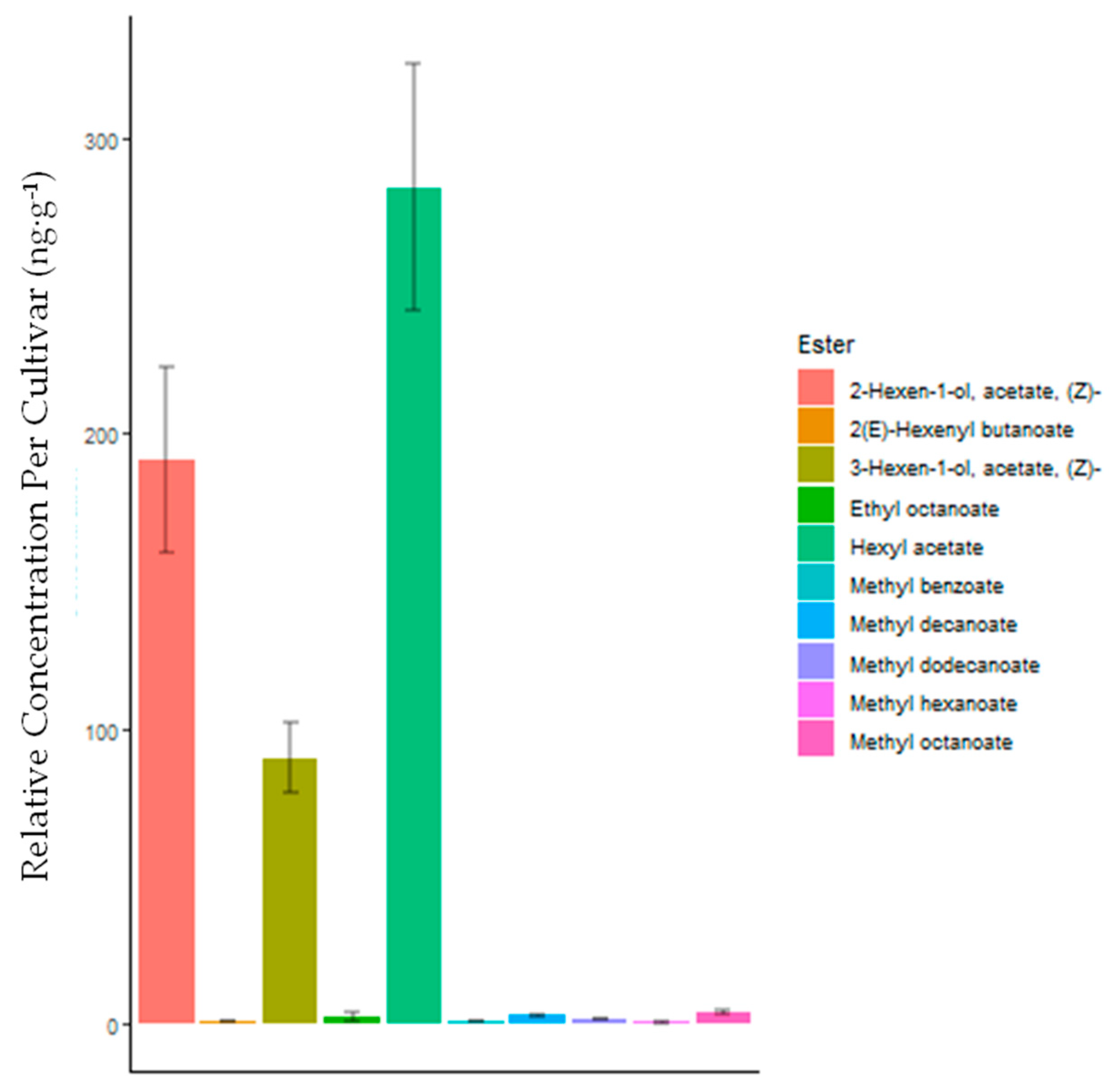
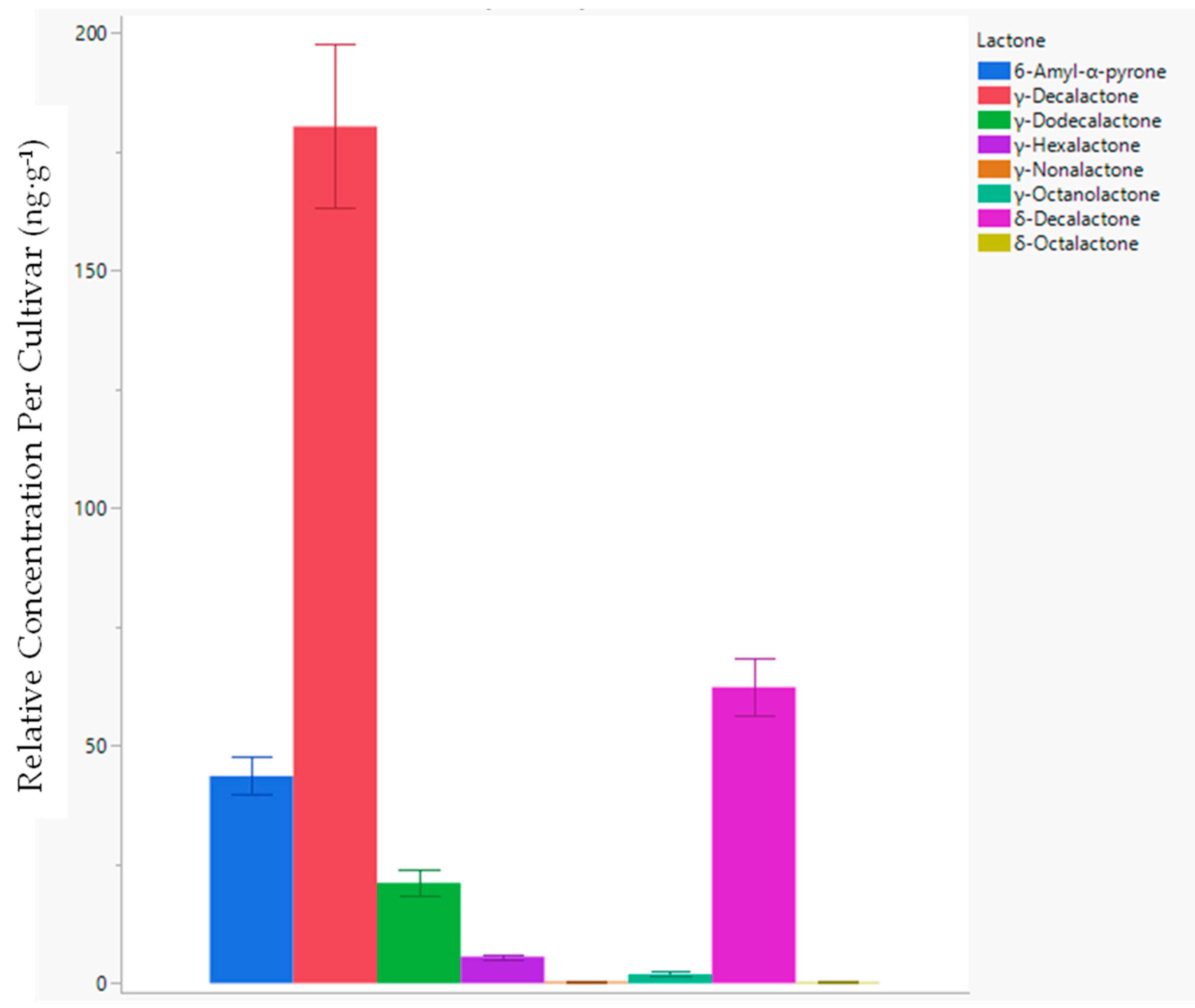
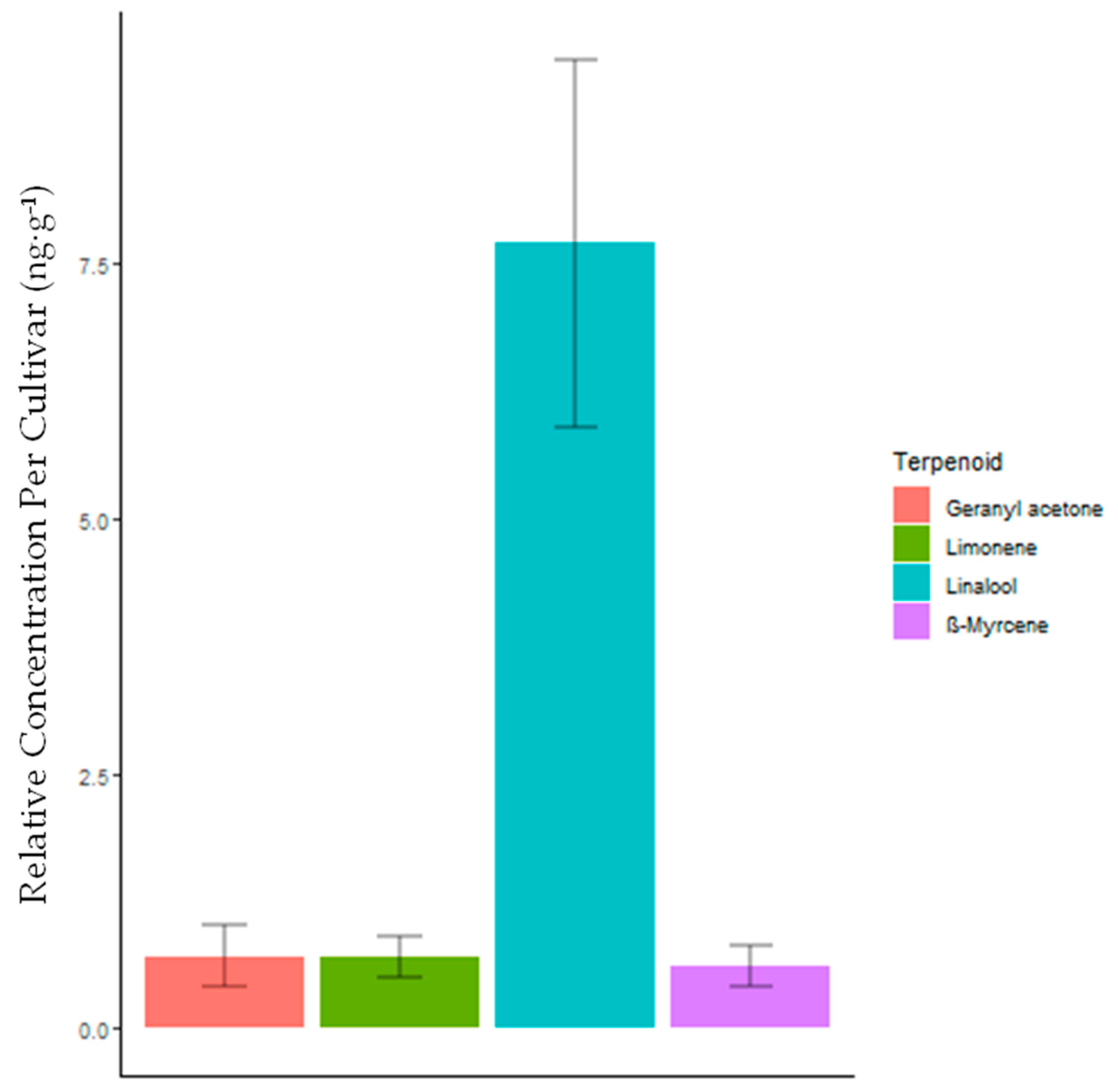
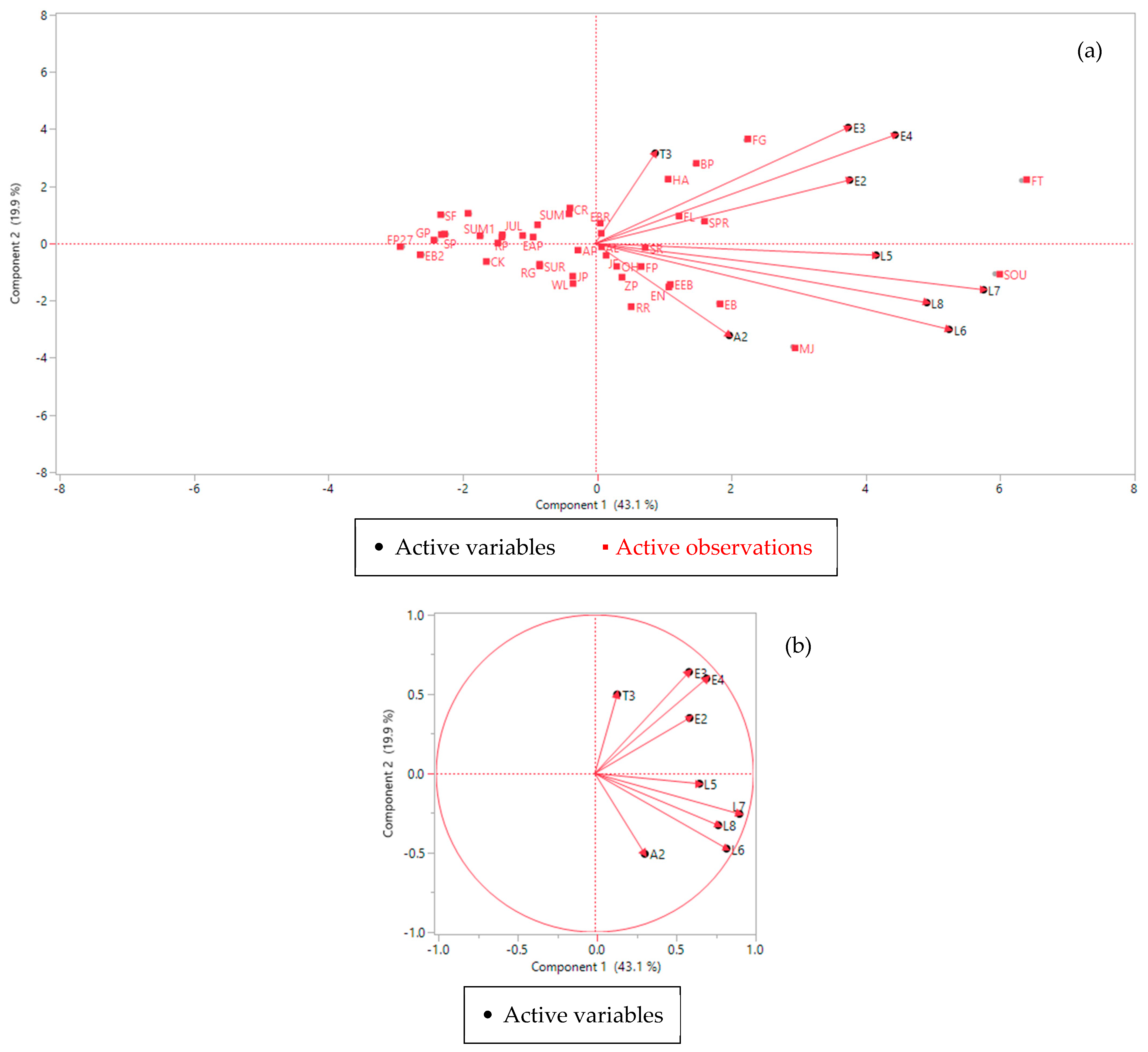
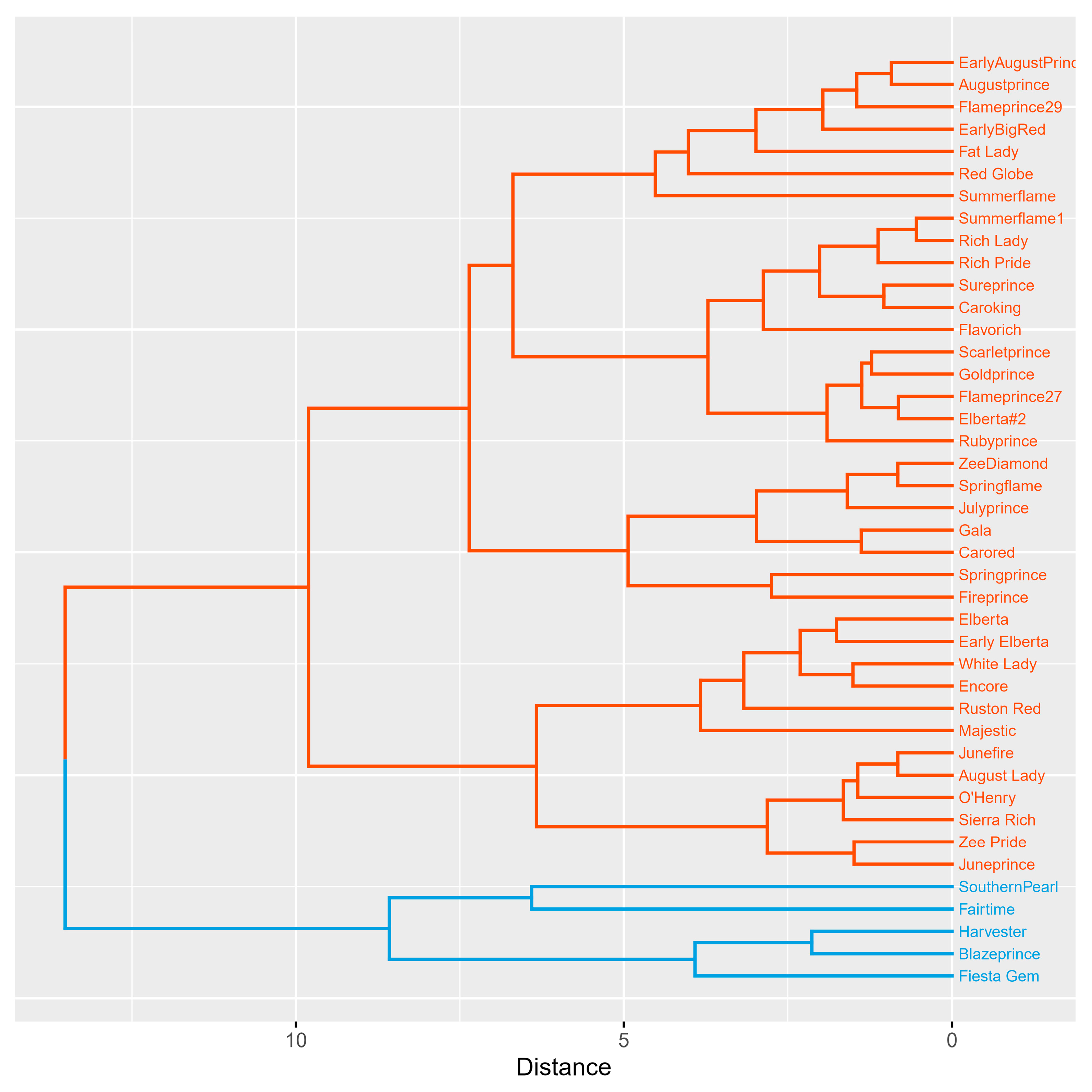
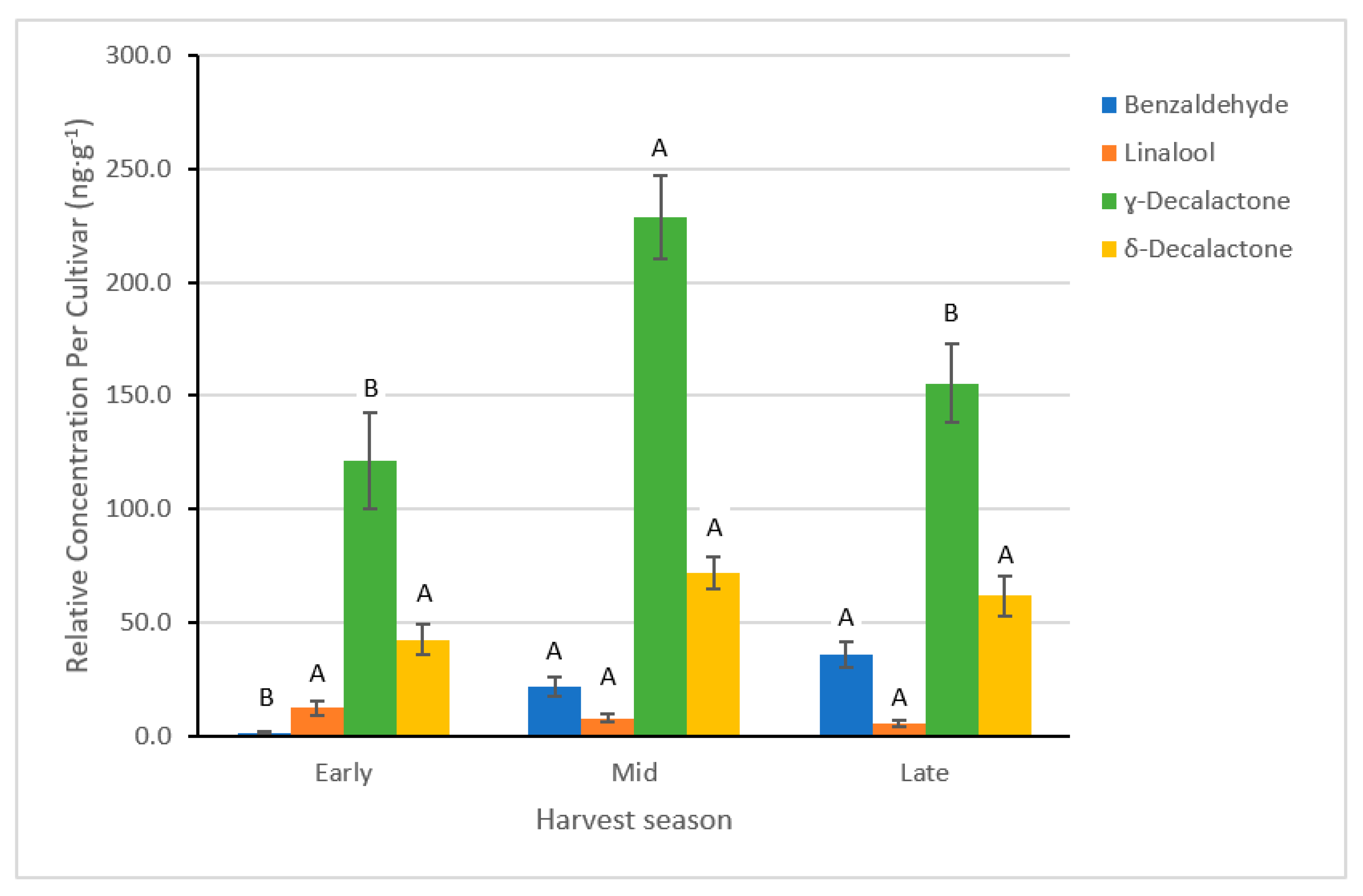
| Harvest Season | Cultivar | Flesh Type | Pit Adherence | Flesh Color | Acidity | Harvest Date a |
|---|---|---|---|---|---|---|
| Early | Carored | Melting | Clingstone | Yellow | Standard | 18 May |
| Fiesta Gem | Melting | Clingstone | Yellow | Standard | 22 May | |
| Flavorich | Melting | Clingstone | Yellow | Standard | 14 May | |
| Goldprince | Melting | Clingstone | Yellow | Standard | 26 May | |
| Rubyprince | Melting | Clingstone | Yellow | Standard | 27 May | |
| Springflame | Nonmelting | Clingstone | Yellow | Standard | 19 May | |
| Springprince | Nonmelting | Clingstone | Yellow | Standard | 18 May | |
| Zee Diamond | Nonmelting | Clingstone | Yellow | Standard | 18 May | |
| Mid | Blazeprince | Melting | Freestone | Yellow | Standard | 14 June |
| Caroking | Melting | Semifreestone | Yellow | Standard | 15 June | |
| Early Elberta | Melting | Freestone | Yellow | Standard | 23 June | |
| Encore | Melting | Freestone | Yellow | Standard | 23 June | |
| Fireprince | Melting | Freestone | Yellow | Standard | 23 June | |
| Gala | Melting | Semifreestone | Yellow | Standard | 2 June | |
| Harvester | Melting | Freestone | Yellow | Standard | 9 June | |
| Junefire | Melting | Freestone | Yellow | Standard | 16 June | |
| Juneprince | Melting | Semifreestone | Yellow | Standard | 1 June | |
| Majestic | Melting | Freestone | Yellow | Standard | 23 June | |
| Rich Lady | Nonmelting | Semifreestone | Yellow | Standard | 9 June | |
| Rich Pride | Nonmelting | Clingstone | Yellow | Standard | 8 June | |
| Scarletprince | Melting | Freestone | Yellow | Standard | 30 June | |
| Sierra Rich | Melting | Freestone | Yellow | Standard | 16 June | |
| Southern Pearl | Melting | Semifreestone | White | Standard | 8 June | |
| Sureprince | Melting | Semifreestone | Yellow | Standard | 2 June | |
| White Lady | Melting | Freestone | White | Low acid | 25 June | |
| Zee Pride | Nonmelting | Clingstone | Yellow | Standard | 1 June | |
| Late | August Lady | Melting | Freestone | Yellow | Standard | 27 July |
| Augustprince | Melting | Freestone | Yellow | Standard | 12 July | |
| Early August Prince | Melting | Freestone | Yellow | Standard | 12 July | |
| Early Big Red | Melting | Freestone | Yellow | Standard | 20 July | |
| Fairtime | Melting | Freestone | Yellow | Standard | 20 July | |
| Fat Lady | Melting | Freestone | Yellow | Standard | 21 July | |
| Flameprince 27 | Melting | Freestone | Yellow | Standard | 29 July | |
| Flameprince 29 | Melting | Freestone | Yellow | Standard | 29 July | |
| Julyprince | Melting | Freestone | Yellow | Standard | 1 July | |
| O’Henry | Melting | Freestone | Yellow | Standard | 29 July | |
| Elberta | Melting | Freestone | Yellow | Standard | 13 July | |
| Elberta #2 b | Melting | Freestone | Yellow | Standard | 21 July | |
| Red Globe | Melting | Freestone | Yellow | Standard | 6 July | |
| Ruston Red | Melting | Freestone | Yellow | Standard | 7 July | |
| Summerflame | Melting | Freestone | Yellow | Standard | 14 July | |
| Summerflame1 | Melting | Freestone | Yellow | Standard | 14 July |
| Classification | Volatile Compounds a | Code b | RI (Exp) c | RI (Lit) d |
|---|---|---|---|---|
| Aldehydes | Hexanal | A1 | 798 | 800 |
| Benzaldehyde | A2 | 962 | 961 | |
| Benzeneacetaldehyde | A3 | 1048 | 1049 | |
| Nonanal | A4 | 1108.5 | 1102 | |
| Decanal | A5 | 1211 | 1195 | |
| Dodecanal | A7 | 1413.7 | 1412 | |
| Alcohols | (E)-3-Hexen-1-ol | B1 | 829 | 845 |
| 2-Hexen-1-ol, (E)- | B2 | 850 | 855 | |
| Hexanol | B3 | 855 | 867 | |
| Octanol | B4 | 1075.3 | 1068 | |
| 1-Nonanol | B5 | 1172.6 | 1172 | |
| 1-Undecanol | B6 | 1371.9 | 1370 | |
| Esters | Methyl hexanoate | E1 | 930 | 924 |
| 3-Hexen-1-ol, acetate, (Z)- | E2 | 1012 | 1011 | |
| Hexyl acetate | E3 | 1019 | 1010 | |
| 2-Hexen-1-ol, acetate, (Z)- | E4 | 1022 | 1007 | |
| Methyl benzoate | E5 | 1101.2 | 1106 | |
| Methyl octanoate | E6 | 1126.6 | 1128 | |
| Ethyl octanoate | E7 | 1201.1 | 1190 | |
| 2(E)-Hexenyl butanoate | E8 | 1202 | 1180 | |
| Methyl decanoate | E9 | 1327.6 | 1328 | |
| Methyl dodecanoate | E10 | 1526.3 | 1527 | |
| Lactones | γ-Hexalactone | L1 | 1061 | 1059 |
| γ-Octanolactone | L2 | 1261.7 | 1260 | |
| δ-Octalactone | L3 | 1291.4 | 1308 | |
| γ-Nonalactone | L4 | 1366.1 | 1363 | |
| 6-Amyl-α-pyrone | L5 | 1459.8 | 1465 | |
| γ-Decalactone | L6 | 1471.7 | 1463 | |
| δ-Decalactone | L7 | 1501.6 | 1496 | |
| γ-Dodecalactone | L8 | 1681.1 | 1671 | |
| Terpenes | β-Myrcene | T1 | 996 | 992 |
| D-Limonene | T2 | 1033 | 1028 | |
| Linalool | T3 | 1104.1 | 1104 | |
| Geranyl acetone | T4 | 1455.8 | 1454 | |
| Carboxylic acids | Benzoic acid | BA | 1165.5 | 1162 |
| Ketones | β-Ionone | K1 | 1492.8 | 1486 |
| Classification | Volatile Compounds | Code a | Early-Season | Mid-Season | Late-Season |
|---|---|---|---|---|---|
| Aldehydes | Hexanal | A1 | 6.1 a b | 1.1 b | 3.2 b |
| Benzaldehyde | A2 | tr | 22.0 b | 35.9 a | |
| Benzeneacetaldehyde | A3 | 0.9 b | 0.9 b | 3.1 a | |
| Nonanal | A4 | 14.5 a | 6.4 b | 5.5 b | |
| Decanal | A5 | 1.4 | 1.5 | 1.7 | |
| Dodecanal | A7 | 0.6 | tr | 0.3 | |
| Alcohols | (E)-3-Hexen-1-ol | B1 | 195.7 a | 37.4 b | 33.2 b |
| 2-Hexen-1-ol, (E)- | B2 | 25.5 ab | 7.5 b | 49.4 a | |
| Hexanol | B3 | 41.7 | 69.7 | 20.7 | |
| Octanol | B4 | 0.3 | 0.1 | tr | |
| 1-Nonanol | B5 | 4.2 a | 3.5 a | 2.3 b | |
| 1-Undecanol | B6 | 23.7 a | 5.4 b | 7.2 b | |
| Esters | Methyl hexanoate | E1 | tr | 0.5 | 0.7 |
| 3-Hexen-1-ol, acetate, (Z)- | E2 | 37.3 c | 82.1 b | 125.6 a | |
| Hexyl acetate | E3 | 379.4 | 258.3 | 263.0 | |
| 2-Hexen-1-ol, acetate, (Z)- | E4 | 273.8 | 165.9 | 177.6 | |
| Methyl benzoate | E5 | 0.7 | 1.3 | 0.6 | |
| Methyl octanoate | E6 | 2.1 b | 5.2 a | 2.6 b | |
| Ethyl octanoate | E7 | tr | 5.6 | tr | |
| 2(E)-Hexenyl butanoate | E8 | 0.4 b | 0.4 b | 1.3 a | |
| Methyl decanoate | E9 | 3.6 | 2.5 | 3.0 | |
| Methyl dodecanoate | E10 | 0.7 | 1.6 | 2.0 | |
| Lactones | γ-Hexalactone | L1 | 4.9 b | 7.0 a | 4.4 b |
| γ-Octanolactone | L2 | tr | 3.6 a | 1.0 b | |
| δ-Octalactone | L3 | tr | 0.6 a | 0.1 b | |
| γ-Nonalactone | L4 | tr | 0.5 | 0.3 | |
| 6-Amyl-α-pyrone | L5 | 30.8 | 48.4 | 44.7 | |
| γ-Decalactone | L6 | 120.6 b | 228.9 a | 155.5 b | |
| δ-Decalactone | L7 | 44.0 | 71.0 | 61.6 | |
| γ-Dodecalactone | L8 | 20.4 | 27.1 | 14.8 | |
| Terpenes | β-Myrcene | T1 | 1.3 | 0.4 | 0.5 |
| D-Limonene | T2 | 0.9 | 0.8 | 0.6 | |
| Linalool | T3 | 16.5 a | 5.9 b | 5.5 b | |
| Geranyl acetone | T4 | 1.9 a | 0.1b | 0.7 b | |
| Carboxylic acids | Benzoic acid | BA | 1.3 b | 0.4 b | 4.1 a |
| Ketones | β-Ionone | K1 | 3.0 | 4.8 | 0.5 |
| Cultivar | ID b | A2 c | E2 | E3 | E4 | L5 | L6 | L7 | L8 | T3 |
|---|---|---|---|---|---|---|---|---|---|---|
| August Lady | AL | tr | 100.9 ± 3.7 | 243.9 ± 45.0 | 120.0 ± 21.8 | 77.7 ± 10.5 | 160.5 ± 6.7 | 78.4 ± 1.7 | 13.4 ± 0.2 | tr |
| Augustprince | AP | 43.0 ± 4.4 d | 100.3 ± 29.1 | 297.8 ± 84.5 | 155.2 ± 46.8 | 52.3 ± 25.6 | 123.5 ± 41.3 | 61.6 ± 14.8 | 12.0 ± 2.6 | tr |
| Blazeprince | BP | tr | 193.9 ± 39.4 | 1023.7 ± 122.8 | 408.0 ± 88.1 | 46.2 ± 7.1 | 184.4 ± 20.9 | 48.3 ± 41.8 | 23.8 ± 0.5 | 18.4 ± 7.6 |
| Caroking | CK | 7.9 ± 6.9 | 33.6 ± 10.5 | 86.7 ± 4.1 | 42.2 ± 14.5 | 20.2 ± 6.9 | 158.6 ± 31.9 | 38.5 ± 6.5 | 16.1 ± 2.6 | tr |
| Carored | CR | tr | 28.6 ± 3.1 | 275.2 ± 93.3 | 232.8 ± 110.1 | 54.1 ± 34.3 | 153.8 ± 92.4 | 51.5 ± 23.2 | 14.3 ± 7.8 | 34.6 ± 28.7 |
| Early August Prince | EAP | 38.1 ± 11.1 | 85.3 ± 29.7 | 354.6 ± 75.5 | 171.4 ± 46.1 | 38.5 ± 25.1 | 90.2 ± 43.0 | 41.1 ± 19.8 | 6.4 ± 3.7 | tr |
| Early Big Red | EBR | 53.5 ± 1.7 | 162.9 ± 13.2 | 399.9 ± 143.5 | 245.2 ± 111.1 | 29.3 ± 3.9 | 139.2 ± 14.0 | 62.9 ± 6.2 | 7.4 ± 1.5 | 13.7 ± 3.1 |
| Early Elberta | EEB | 49.9 ± 49.3 | 72.8 ± 20.5 | 271.8 ± 54.8 | 215.4 ± 47.7 | 33.9 ± 12.9 | 328.1 ± 106.6 | 72.0 ± 66.2 | 44.3 ± 11.2 | tr |
| Encore | EN | 39.5 ± 11.9 | 64.0 ± 9.0 | 244.2 ± 77.7 | 115.5 ± 36.6 | 57.1 ± 21.0 | 292.7 ± 17.9 | 102.5 ± 47.3 | 32.6 ± 16.0 | tr |
| Fairtime | FT | tr | 410.8 ± 20.9 | 819.8 ± 68.7 | 685.6 ± 131.5 | 134.0 ± 85.3 | 394.2 ± 240.5 | 189.3 ± 191.3 | 31.1 ± 17.5 | 20.6 ± 11.7 |
| Fat Lady | FL | 68.9 ± 80.2 | 153.7 ± 103.0 | 684.7 ± 545.2 | 432.2 ± 372.1 | 66.7 ± 35.3 | 181.9 ± 107.4 | 39.6 ± 35.1 | 14.0 ± 8.0 | 5.4 ± 5.0 |
| Fiesta Gem | FG | tr | 101.1 ± 102.9 | 1129.8 ± 454.0 | 921.9 ± 417.8 | 19.7 ± 11.5 | 112.7 ± 47.4 | 52.7 ± 26.4 | 54.4 ± 33.9 | 18.0 ± 2.2 |
| Fireprince | FP | 38.6 ± 4.3 | 77.4 ± 9.7 | 116.8 ± 92.9 | 69.1 ± 30.1 | 49.9 ± 12.0 | 327.5 ± 74.7 | 84.7 ± 13.5 | 22.3 ± 7.4 | 26.9 ± 23.6 |
| Flameprince27 | FP27 | 17.5 ± 3.7 | 21.5 ± 8.5 | 40.5 ± 16.3 | 37.8 ± 17.1 | 15.2 ± 3.6 | 27.1 ± 9.2 | 12.6 ± 4.1 | tr | tr |
| Flameprince29 | FP29 | 47.3 ± 10.5 | 154.7 ± 81.9 | 419.3 ± 296.9 | 183.7 ± 122.3 | 30.1 ± 15.5 | 64.2 ± 37.6 | 36.6 ± 22.5 | 2.5 ± 0.6 | tr |
| Flavorich | FR | tr | 31.6 ± 2.7 | 453.1 ± 109.1 | 322.7 ± 5.9 | 29.0 ± 8.0 | 161.9 ± 29.4 | 72.0 ± 22.8 | 30.9 ± 8.7 | tr |
| Gala | GA | tr | 22.4 ± 3.8 | 100.3 ± 72.0 | 46.0 ± 26.5 | 54.5 ± 17.4 | 131.9 ± 49.8 | 43.5 ± 8.7 | 17.7 ± 8.0 | 26.1 ± 7.0 |
| Goldprince | GP | tr | 21.9 ± 2.3 | 125.1 ± 61.1 | 92.4 ± 45.1 | 16.9 ± 7.9 | 63.7 ± 25.0 | 14.2 ± 4.3 | 10.2 ± 0.3 | tr |
| Harvester | HA | 25.3 ± 26.8 | 96.2 ± 27.0 | 771.7 ± 345.9 | 504.7 ± 210.2 | 39.2 ± 11.7 | 160.7 ± 77.7 | 72.8 ± 31.2 | 13.8 ± 0.9 | 25.7 ± 11.5 |
| Julyprince | JUL | 14.4 ± 12.5 | 65.6 ± 35.3 | 107.7 ± 83.4 | 63.5 ± 40.4 | 22.6 ± 6.2 | 142.2 ± 54.2 | 54.4 ± 12.2 | 3.6 ± 1.4 | 21.4 ± 4.4 |
| Junefire | JF | 12.6 ± 15.1 | 90.7 ± 76.3 | 240.0 ± 219.1 | 136.8 ± 143.0 | 62.6 ± 32.1 | 197.3 ± 111.7 | 79.1 ± 26.1 | 16.3 ± 8.0 | tr |
| Juneprince | JP | tr | 28.4 ± 5.1 | 31.2 ± 18.3 | 41.0 ± 7.6 | 84.1 ± 18.5 | 213.9 ± 3.1 | 48.1 ± 40.0 | 27.4 ± 1.8 | tr |
| Majestic | MJ | 87.1 ± 10.6 | 87.8 ± 17.0 | 90.5 ± 41.4 | 42.4 ± 5.6 | 67.1 ± 24.4 | 502.8 ± 176.8 | 135.2 ± 80.3 | 55.9 ± 46.3 | tr |
| O’Henry | OH | 31.7 ± 9.0 | 152.1 ± 43.2 | 141.6 ± 54.6 | 55.8 ± 27.6 | 68.0 ± 12.5 | 184.8 ± 49.1 | 84.1 ± 24.8 | 15.7 ± 5.1 | tr |
| Elberta | EB | 29.6 ± 12.6 | 49.4 ± 11.3 | 224.3 ± 175.1 | 111.0 ± 72.4 | 57.5 ± 27.4 | 383.7 ± 98.5 | 104.6 ± 47.3 | 56.7 ± 7.8 | tr |
| Elberta #2 | EB2 | 36.1 ± 7.5 | 28.6 ± 28.6 | 61.4 ± 22.3 | 54.6 ± 17.9 | 6.4 ± 3.0 | 51.9 ± 11.4 | 14.1 ± 12.3 | 5.5 ± 1.1 | tr |
| Red Globe | RG | 88.6 ± 61.3 | 71.8 ± 5.7 | 50.5 ± 12.8 | 38.5 ± 13.4 | 23.3 ± 9.0 | 139.6 ± 47.4 | 68.0 ± 24.0 | 5.7 ± 3.6 | 26.1 ± 8.4 |
| Rich Lady | RL | tr | 69.9 ± 14.5 | 160.9 ± 54.1 | 79.0 ± 24.4 | 40.9 ± 31.5 | 114.6 ± 15.4 | 35.1 ± 0.8 | 9.7 ± 1.8 | tr |
| Rich Pride | RP | tr | 63.1 ± 24.8 | 138.4 ± 96.2 | 67.9 ± 40.2 | 51.4 ± 17.6 | 108.8 ± 9.7 | 32.2 ± 4.1 | 9.4 ± 1.5 | 8.9 ± 8.4 |
| Rubyprince | RUB | tr | tr | 415.7 ± 124.8 | tr | 13.9 ± 2.6 | 69.0 ± 18.7 | 30.3 ± 3.2 | 6.0 ± 1.6 | tr |
| Ruston Red | RR | 104.9 ± 27.9 | 52.7 ± 14.9 | 190.1 ± 32.1 | 113.7 ± 27.8 | 29.2 ± 10.0 | 225.1 ± 69.4 | 66.6 ± 19.9 | 43.8 ± 25.8 | tr |
| Scarletprince | SP | 11.7 ± 10.2 | 99.5 ± 35.6 | 162.6 ± 62.3 | 55.4 ± 8.7 | 6.1 ± 0.8 | 56.6 ± 10.4 | 20.2 ± 3.5 | 4.1 ± 0.7 | tr |
| Sierra Rich | SR | tr | 180.3 ± 131.6 | 172.8 ± 178.5 | 183.8 ± 137.4 | 76.4 ± 33.3 | 243.3 ± 73.3 | 63.5 ± 55.0 | 21.9 ± 5.6 | tr |
| Southern Pearl | SOU | 85.4 ± 42.0 | 170.5 ± 86.1 | 752.6 ± 507.3 | 725.8 ± 425.5 | 46.0 ± 22.5 | 442.9 ± 233.3 | 190.9 ± 98.0 | 84.1 ± 44.0 | tr |
| Springflame | SF | tr | 37.2 ± 14.4 | 139.3 ± 75.0 | 101.5 ± 38.1 | 16.2 ± 2.7 | 54.1 ± 8.3 | 22.4 ± 3.2 | 2.2 ± 0.5 | 21.5 ± 4.8 |
| Springprince | SPR | tr | 51.1 ± 49.8 | 293.4 ± 363.9 | 302.7 ± 318.3 | 83.7 ± 82.4 | 280.4 ± 242.5 | 81.3 ± 65.3 | 37.5 ± 37.6 | 40.8 ± 0.9 |
| Summerflame | SUM | tr | 91.8 ± 53.8 | 171.1 ± 140.2 | 75.5 ± 59.1 | 33.7 ± 14.1 | 90.1 ± 39.1 | 23.8 ± 21.4 | 8.2 ± 4.6 | tr |
| Summerflame1 | SUM1 | tr | 307.1 ± 192.3 | tr | 297.6 ± 103.1 | 29.7 ± 10.8 | 89.4 ± 42.6 | 48.4 ± 25.9 | 10.4 ± 18.0 | tr |
| Sureprince | SUR | tr | 36.5 ± 0.1 | 108.6 ± 31.6 | 63.7 ± 61.8 | 36.6 ± 15.5 | 193.8 ± 81.7 | 54.9 ± 21.7 | 26.1 ± 6.3 | tr |
| White Lady | WL | 37.9 ± 3.1 | 43.9 ± 11.1 | 91.1 ± 30.2 | 70.0 ± 17.1 | 36.7 ± 10.2 | 220.3 ± 48.4 | 77.8 ± 77.9 | 21.2 ± 3.9 | tr |
| Zee Diamond | ZD | tr | 26.4 ± 4.4 | 203.5 ± 87.0 | 216.4 ± 41.9 | 13.0 ± 2.9 | 69.3 ± 24.0 | 27.8 ± 9.8 | 7.7 ± 2.7 | 17.0 ± 2.4 |
| Zee Pride | ZP | tr | 46.2 ± 9.5 | 86.7 ± 87.1 | 120.2 ± 98.5 | 61.5 ± 22.6 | 241.2 ± 75.2 | 78.0 ± 22.5 | 41.1 ± 19.1 | tr |
Publisher’s Note: MDPI stays neutral with regard to jurisdictional claims in published maps and institutional affiliations. |
© 2021 by the authors. Licensee MDPI, Basel, Switzerland. This article is an open access article distributed under the terms and conditions of the Creative Commons Attribution (CC BY) license (https://creativecommons.org/licenses/by/4.0/).
Share and Cite
Mohammed, J.; Belisle, C.E.; Wang, S.; Itle, R.A.; Adhikari, K.; Chavez, D.J. Volatile Profile Characterization of Commercial Peach (Prunus persica) Cultivars Grown in Georgia, USA. Horticulturae 2021, 7, 516. https://doi.org/10.3390/horticulturae7120516
Mohammed J, Belisle CE, Wang S, Itle RA, Adhikari K, Chavez DJ. Volatile Profile Characterization of Commercial Peach (Prunus persica) Cultivars Grown in Georgia, USA. Horticulturae. 2021; 7(12):516. https://doi.org/10.3390/horticulturae7120516
Chicago/Turabian StyleMohammed, Jamal, Catherine E. Belisle, Shangci Wang, Rachel A. Itle, Koushik Adhikari, and Dario J. Chavez. 2021. "Volatile Profile Characterization of Commercial Peach (Prunus persica) Cultivars Grown in Georgia, USA" Horticulturae 7, no. 12: 516. https://doi.org/10.3390/horticulturae7120516
APA StyleMohammed, J., Belisle, C. E., Wang, S., Itle, R. A., Adhikari, K., & Chavez, D. J. (2021). Volatile Profile Characterization of Commercial Peach (Prunus persica) Cultivars Grown in Georgia, USA. Horticulturae, 7(12), 516. https://doi.org/10.3390/horticulturae7120516







